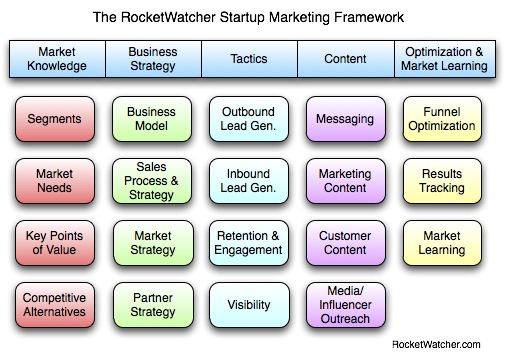Editor’s note: This is a guest post by serial entrepreneur and marketing executive April Dunford who is currently the head of Enterprise Market Strategy for Huawei. April specializes in brining new products to market including messaging, positioning, market strategy, go-to-market planning and lead generation. She is one of the leading B2B/enterprise marketers in the world and we’re really lucky to be able to share here content with you. Follow her on Twitter @aprildunford or RocketWatcher.com. This post was originally published in June 9, 2011 on RocketWatcher.com.

![]()
![]() Some rights reserved by s?ndy°
Some rights reserved by s?ndy°
As marketers we are often so focused on new customer acquisition that we sometime forget to pay attention to the customers that we already have. That would be a massive mistake.
It costs 6-7 times more to acquire a new customer than it does to keep an existing one. You are 4 times more likely to close business with an existing customer than you are with a new prospect.
I recently brainstormed with a CEO about programs for their current customers both to improve customer retention as well as to drive new business – here are some of the ideas we came up with:
1/ Give your Newsletter a Kick in the Pants – We all get too much email. Your newsletter is going to have to kick ass just to get folks to open it, let alone take action. What could you give customers that would be so interesting, awesome or remarkable that they’ll say, “Yippie, the newsletter arrived today!” What works for you will depend on your market but I’ve seen good results with sample code, a customer spotlight feature, sharing industry data your customers don’t have access to, interviews with industry experts and video snippets of product managers or support folks sharing their favorite tips and tricks. I’m sure you could come up with a hundred other ideas. If your newsletter doesn’t feel like hard work to create, you could probably do better.
2/ Campaign to your Lost Customers – You are twice as likely to close business with a lost customer than you are with a new prospect. With close rates like that, you should be treating these folks like hot leads. Doing win-loss interviews can help you identify patterns around what went wrong in the first place and get clues as to what to offer them to come back.
3/ Campaign to your Inactive Accounts – These folks are like a loveless marriage – they haven’t divorced you yet but the thrill is gone. Maybe they stopped paying for maintenance during the downturn because of cost-cutting, or needed a feature you didn’t have (or they didn’t know you had), maybe there weren’t enough people signed up at the time to make the service interesting or maybe they were never really “activated” customers in the first place. Similar to a win-loss analysis you’ll want to get on the phone with a bunch of these folks to figure out what the patterns are and how you might get them to, ah, renew their vows with you.
4/ Get Marketing and Customer Service Talking to Each Other – Only 10% of your unhappy customers will tell you. The others tell their friends. Your communications to your customer base can help keep customers informed and that’s a good reason to get marketing and customer service talking to each other. Marketing can help communicate workarounds for common problems or information about expected fix dates for known issues. And don’t forget to make it easy for people to complain via any of your communications channels (including the marketing ones). The sooner you know, the sooner you can do something about it.
5/ Expand Inside Accounts – Think about ways to expand your reach inside larger accounts if you sell B2B. I once convinced a big retailer that had done a small deal with us to let us do a free coffee and donuts event in their cafeteria that turned into 2 six-figure deals. Don’t be shy about asking your sponsor inside a large account about how you might start a conversation with other groups.
6/ Help Customers Promote Themselves – Smaller companies are looking for ways to promote their products and services and drive links back to their own sites. I once had a Fortune 500 CIO agree to do a video testimonial with me mainly because he was a new CIO and wanted to raise his own personal profile for his next job. I always wonder why companies don’t give more awardsto their customers and partners. Everyone loves to get an award no matter who’s giving it out and when they brag about winning the “Excellence in Accounting Software Deployment” award, they’ll likely mention your name too.
7/ Show Them the Love (at least 20% of them anyway) – A few months ago I signed up for a pre-launch list for a new service. I was asked to Tweet about it as part of the sign-up, which I did. After the launch I got a form email thanking me for being a top driver of referrals (plus a t-shirt if I sent them my address). A personal email would have made a MUCH bigger impact on me, and how much time would it have taken? I bet I could write 100 of them in a day. I don’t want a t-shirt (side note–if your customers include women, you might want to re-think the whole t-shirt thing), I want to be thanked like a person and not some a faceless “top referrer.” Your business makes 80% of it’s revenue from 20% of your customers. Quit being so lazy – pick up the phone and pucker up.
Editor’s note: This is a guest post by serial entrepreneur and marketing executive April Dunford who is currently the head of Enterprise Market Strategy for Huawei. April specializes in brining new products to market including messaging, positioning, market strategy, go-to-market planning and lead generation. She is one of the leading B2B/enterprise marketers in the world and we’re really lucky to be able to share here content with you. Follow her on Twitter @aprildunford or RocketWatcher.com. This post was originally published in June 9, 2011 on RocketWatcher.com.


